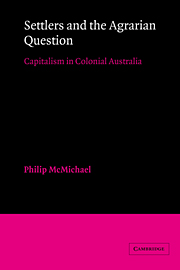Book contents
- Frontmatter
- Contents
- List of tables
- Preface
- 1 The social structure of British hegemony
- PART I THE COLONIAL ECONOMY ENTERS THE WORLD MARKET (1788–1830)
- PART II THE SQUATTING PHASE OF PASTORALISM (1830s AND 1840s)
- PART III CONFRONTING THE AGRARIAN QUESTION (1840–1900)
- 8 The 1840s crisis and social transition
- 9 Foundations of the agrarian question
- 10 State formation and transformation of the landed economy
- Conclusion
- APPENDIXES
- References
- Index
8 - The 1840s crisis and social transition
Published online by Cambridge University Press: 18 December 2009
- Frontmatter
- Contents
- List of tables
- Preface
- 1 The social structure of British hegemony
- PART I THE COLONIAL ECONOMY ENTERS THE WORLD MARKET (1788–1830)
- PART II THE SQUATTING PHASE OF PASTORALISM (1830s AND 1840s)
- PART III CONFRONTING THE AGRARIAN QUESTION (1840–1900)
- 8 The 1840s crisis and social transition
- 9 Foundations of the agrarian question
- 10 State formation and transformation of the landed economy
- Conclusion
- APPENDIXES
- References
- Index
Summary
INTRODUCTION
The colonial depression in the early 1840s was primarily due to a crisis in the pastoral industry and its relations with the world market. Existing accounts of the depression extensively document its cyclical characteristics but pay little attention to its historical impact on capitalist development in Australia. In this chapter I will analyze the depression as a crystallization of the barriers to capital accumulation in the colony imposed by pastoralism. Whereas this is the focus of the chapter, there is a further implication to be drawn; that concerns the contradictory political responses (consolidation versus subordination of the squatter economy) to the external vulnerability of the pastoral economy revealed in the depression. These responses structured subsequent political debate in colonial Australia. The argument here is that the 1840s depression was a significant threshold in colonial political and economic development.
In the imperial context, there was a close correlation between the trade cycles in Britain and colonial Australia (Hartwell 1954b). More particularly, there was a steady downward trend in wool prices in London (where most Australian wool was sold) during the late 1830s, culminating in a depression in the English textile industry in the early 1840s. Two primary forces affected the reproductive circuit of industrial capital in textile manufacture. On the one hand, British capitalism entered a cyclical downturn in which demand decreases in woolen export markets exacerbated the excess capacity of the textile industry (following industrialization). Wool prices in London dipped sharply.
- Type
- Chapter
- Information
- Settlers and the Agrarian QuestionCapitalism in Colonial Australia, pp. 167 - 190Publisher: Cambridge University PressPrint publication year: 1984



